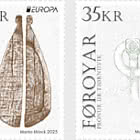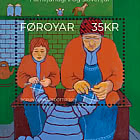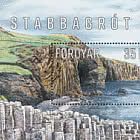- Home
- Stamps
- Faroe Islands
- 2021
Franking Labels
Franking labels 2021: Storytellers
We have always had great storytellers and raconteurs in all the diverse cultures of the world. Good raconteurs are culture-bearing aesthetic spirits who have shaped and influenced our cultural identity for better or worse. Whoever you are and wherever you live, you can unquestionably name some well-known personalities who have shaped your culture and probably quite a few unknown raconteurs as well.
This is also the case with the Faroe Islands and Faroese culture. At the mention of Jørgen Frantz Jacobsen (1900 - 1938), a female image will pop up in the mind of any Faroese. A young tuberculosis-stricken student, historian, journalist and writer, JF Jacobsen’s troublesome life and unrequited infatuation instantly conjures up the magnificent romance novel “Barbara.”
Barbara was a beautiful, fickle and deceitful woman - which is probably why the artist Bárður Dal Christiansen has fitted her with rocket engine on the stamp. Barbara’s image was partly based on the legendary figure Beinta Arhboe (born Broberg), who married three priests, two of whom died relatively young while the third went insane – and partly on Jacoben's unfortunate passion for his cousin Estrid Bannister Good, who viewed the relationship between the two as friendship and was not attracted to him. There is not much similarity between the legend's factual "femme fatale" and the novel's carefree and jovial but fickle Barbara. Both of them lack the ability to limit their affection to just one man - which ultimately leads to an unhappy ending.
The name of Heðin Brú, the nom de plume of Hans Jacob Jacobsen (1901 - 1987), is immediately associated with stories from times of upheaval - the societal development of the Faroe Islands’ emerging from an almost medieval peasant society to modern fishing nation. His most famous and beloved novel is "Feðgar á ferð" (Poor Man’s Honour in Danish), a warm-hearted and slightly tragicomic account of the confrontation between the sense of honour and morality of the old peasant society and that of the new fishing industry. Ketil, an old man of honour, has had a few drinks too many following a whale hunt - and arrives in uplifted mood to buy a pilot whale at an auction. The rest of the novel deals with his, and his slow-witted youngest son "Kálvur", efforts to raise funds to pay off his auction debt in order to avoid the ultimate indignity of having to sell his only cow.
Dr. Jakob Jakobsen (1864 - 1918) was a Faroese linguist and folklore collector, known among other things for his dissertations on Nordic elements in the languages, traditions and legends of Shetland and the Orkney Islands. Dr. Jakobsen’s best-known work, "Faroese Folktales and Fairy Tales" was published in the Faroe Islands in 1901. This motley collection of folk lore and fairy tales was collected during his extensive trips in the Faroe Islands in 1892-93 and again in 1898. Dr. Jakobsen's work provides, in addition to the semi-historical tales, an insight into a magical world, populated with Hidden People (elves), trolls and similar supernatural beings still present in the culture and minds of the Faroese.
Discussing Faroese storytellers, one cannot possibly bypass the most famous and fabled of them all: William Heinesen (1900 - 1991). Heinesen’s literary universe lends serpentine angles even to the square and conventional. In his accounts of Tórshavn's narrow alleys and clustered houses in the first half of the last century harsh realism goes hand in hand with a magnificent mythical universe.
The artist Bárður Dal Christiansen has chosen "Mother Seven Stars” as the last motif on this year's franking stamps, where a mythical universe is constantly being confronted and threatened by gloomy fundamentalist Christianity. The beautiful and vivacious Antonia, who has an extramarital son, incurs the "Spanish flu" at his baptism and dies, leaving the child on his own. He grows up without the mother who according to his nanny, Rita, dwells in the rose garden of Paradise with her forehead crowned by the seven stars of the Pleiades. The little boy's mythical universe is for better or worse constantly confronted by morbid perceptions of Christianity and reality, especially represented by the old maiden called “Trine with the Eyes“. It is a beautiful and at the same time frightening story, told in an inspired manner by an ingenious Storyteller.
Anker Eli Petersen
Faroe Islands - Recommended stamp issues
WOPA+ recommended stamp issues
| Avatar - Fire and Ash |
| Issued: 03.12.2025 |
| ›New Zealand |
| 50th Anniversary of the Founding of the 24th November Bar Scout |
| Issued: 24.11.2025 |
| ›Montenegro |
| Krisjanis Valdemars |
| Issued: 02.12.2025 |
| ›Latvia |
| Sign Language - Good |
| Issued: 02.12.2025 |
| ›Bosnia and Herzegovina - Republic of Srpska |
| In Memory of the Fallen and Murdered on October 7, 2023 |
| Issued: 08.10.2025 |
| ›Israel |
| Annual Collection Folder (New York) |
| Issued: 05.12.2025 |
| ›United Nations |
| Year Set |
| Issued: 24.11.2025 |
| ›Isle of Man |
| Shipping in the 17th and 18th Centuries - Peat Shipping |
| Issued: 05.12.2025 |
| ›Netherlands |

































